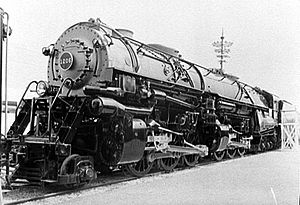
2-6-6-4
Encyclopedia

Whyte notation
The Whyte notation for classifying steam locomotives by wheel arrangement was devised by Frederick Methvan Whyte and came into use in the early twentieth century encouraged by an editorial in American Engineer and Railroad Journal...
for the classification of steam locomotive
Steam locomotive
A steam locomotive is a railway locomotive that produces its power through a steam engine. These locomotives are fueled by burning some combustible material, usually coal, wood or oil, to produce steam in a boiler, which drives the steam engine...
wheel arrangement
Wheel arrangement
In rail transport, a wheel arrangement is a system of classifying the way in which wheels are distributed beneath a locomotive.. Several notations exist to describe the wheel assemblies of a locomotive by type, position, and connections, with the adopted notations varying by country...
, a 2-6-6-4 is a locomotive with a two-wheel leading truck, two sets of six driving wheel
Driving wheel
On a steam locomotive, a driving wheel is a powered wheel which is driven by the locomotive's pistons...
s, and a four-wheel trailing truck. All 2-6-6-4s have been articulated locomotive
Articulated locomotive
Articulated locomotive usually means a steam locomotive with one or more engine units which can move independent of the main frame. This is done to allow a longer locomotive to negotiate tighter curves...
s, of the Mallet
Mallet locomotive
The Mallet Locomotive is a type of articulated locomotive, invented by a Swiss engineer named Anatole Mallet ....
or related simple articulated type.
Other equivalent classifications are:
- UIC classificationUIC classificationThe UIC classification of locomotive axle arrangements describes the wheel arrangement of locomotives, multiple units and trams. It is set out in the International Union of Railways "Leaflet 650 - Standard designation of axle arrangement on locomotives and multiple-unit sets". It is used in much...
: (1'C)C2' (also known as German classification and Italian classification) - French classification: 130+032
- Turkish classificationTurkish classificationIn the Turkish classification system for railway locomotives, the number of powered axles are followed by the total number of axles. It is identical to the Swiss system except that the latter places a slash between the two numbers.Thus0-6-0 becomes 33...
: 34+35 - Swiss classification: 3/4+3/5
The UIC classification
UIC classification
The UIC classification of locomotive axle arrangements describes the wheel arrangement of locomotives, multiple units and trams. It is set out in the International Union of Railways "Leaflet 650 - Standard designation of axle arrangement on locomotives and multiple-unit sets". It is used in much...
is refined to (1'C)C2' for Mallet locomotives.
The 2-6-6-4 was a fairly late development, a product of the superpower steam
Superpower steam
"Superpower steam" was a term coined by Lima Locomotive Works in the mid-1920s. It referred to steam locomotives with booster-equipped four-wheel trailing trucks supporting large fireboxes, as well as enlarged superheaters. The wheel arrangements introduced in the 20s for these locomotives included...
concept, introduced by the Lima Locomotive Works
Lima Locomotive Works
Lima Locomotive Works was an American firm that manufactured railroad locomotives from the 1870s through the 1950s. The company took the most distinctive part of its name from its main shops location in Lima, Ohio. The shops were located between the Baltimore & Ohio's Cincinnati-Toledo main line...
, which encouraged the use of large fireboxes supported by four-wheel trailing trucks. Such a firebox could sustain a rate of steam generation to meet any demands of the locomotive's cylinders, even at high speed. High speeds were certainly among the design goals for a 2-6-6-4; most of the type were intended for use on fast freight trains.
The first 2-6-6-4s built in the United States
United States
The United States of America is a federal constitutional republic comprising fifty states and a federal district...
were for the Pittsburgh & West Virginia Railroad, and these were not high speed locomotives but rather heavy mountain luggers. They received three in 1934 and four more in 1937.
The next of the type were a successful class of ten ordered by the Seaboard Air Line in 1935 and 1937. These were high speed freight engines and were very successful. Upon dieselisation
Dieselisation
Dieselisation or dieselization is a term generally used for the increasingly common use of diesel fuel in vehicles, as opposed to gasoline or steam engines.-Water Transport:...
, the road sold the locomotives to the Baltimore & Ohio Railroad in 1947, who operated them until 1953.
The final class of 2-6-6-4s was the Norfolk & Western Railway's Class A, built starting in 1936. 43 were built until 1950. They were the largest until the 4-8-8-4 Union Pacific Big Boy was produced. The powerful 2-6-6-4s were capable of 6,300 drawbar horsepower (4.7 MW) at 45 mph (72 km/h) and able to run at over 70 mph (110 km/h), but were also capable of lugging heavy unit coal trains. They were used until dieselisation in 1959. One locomotive, Norfolk & Western 1218
Norfolk & Western 1218
Norfolk & Western 1218 is a steam locomotive that at one time was the strongest-pulling operational steam locomotive in the world. It is a four-cylinder simple articulated locomotive with a 2-6-6-4 wheel arrangement. The Norfolk & Western Railway built it in 1943 at its Roanoke Shops in Roanoke,...
, was preserved and in 1987 was restored to running order, running on frequent excursions until 1991. Today it is on display at the Virginia Museum of Transportation
Virginia Museum of Transportation
The Virginia Museum of Transportation is a museum devoted to the topic of transportation located in Downtown Roanoke, Virginia, U.S.A..- History :...
.
In all, 60 2-6-6-4s were constructed in North America.
External links
- picture of N&W 1218 pulling an excursion train in 1988
- side view of N&W 1218 under steam in 1987
- builder's photo of N&W 1212, engineer's side, Virginia Tech collection
- builder's photo of N&W 1212, fireman's side, Virginia Tech collection

